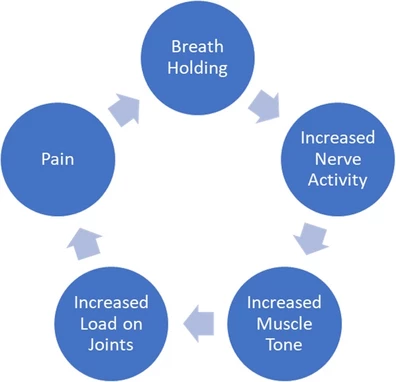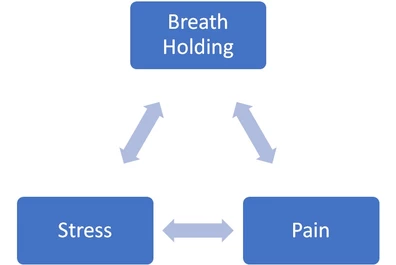Vicious Cycles & Breathing
September 13, 2018
I promised more blog posts on specifics related to chronic pain, so here we go.
A lot of chronic pain is related to vicious cycles. A lot of the management of chronic pain involves recognising these vicious cycles, breaking them and creating ‘virtuous cycles’.
Here’s an interesting vicious cycle related to pain, particularly chronic neck and or back pain.

When you’re in pain you tend to hold your breath during activity, and/or breathe quite shallowly from the upper chest. Upper chest breathing and breath holding actually has the effect of increasing the activity in motor nerves supplying muscles of the neck and back. As a result these muscles have greater resting tone and feel tight. This increased resting tone also increases the forces going through joints in the back because the muscles are pulling the two ends of the joint into each other. The increased tone in the muscles and increased force across the joints can translate to an increase in pain. And so the vicious cycle is completed.
To add to this, stress tends to make you breathe from your upper chest rather than your diaphragm. And as we’ve seen above, upper chest breathing can cause a vicious cycle which creates an increase in pain. An increase in pain is also likely to contribute to an increase in your stress.

To take it one step further, stress and pain are both factors which commonly contribute to a lack of good quantity and quality of sleep. Lack of sleep then reciprocally increases stress and increases pain.

There are many tools we can potentially use to begin to break these vicious cycles and create ‘virtuous cycles’. One you can try yourself at home is practicing diaphragmatic breathing. To do this follow these steps
- Lie down somewhere quiet where you can be alone. (Once you get used to diaphragmatic breathing you can start to practice it anywhere and in different postures, but this is a good way to start)
- Focus on your breathing. Try to eliminate any other thoughts
- If you do have a thought about something else, calmly visualise the thought leaving you and return to focusing on breathing
- Breathe slightly deeper than normal breathing, but without forcing the air in or out
- As you breathe in, visualise that you are filling all the way to the bottom of your lungs and that the bottom of your lungs are pushing down into your stomach
- Relax the breath out
Diaphragmatic breathing has the effect of reducing resting muscle tone in muscles in the back, and slowing down activity in the nervous system, which helps reduce stress and pain.
-
 What Can Make Neck Pain a Headache?
What Can Make Neck Pain a Headache?
Often people experiencing a headache are also experiencing neck pain/tightness a...
-
 How Physio Can Help Your Headaches
How Physio Can Help Your Headaches
Headaches are no fun. Some people will only experience short-term headaches ever...
-
 Muscle Strains
Muscle Strains
Winter sports are back and with them come more muscle strains, particularly hams...
